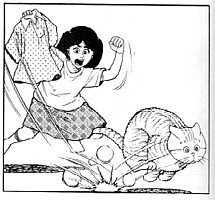

On this page I will review more translated Japanese manga.
Note that the quality of the images, reproduced here for bona fide review purposes, has been affected by the scanning and compression processes, so if you want to see how the originals look, you'll have to buy the books!
REVIEW
ADOLF-Days of Infamy by Osamu TEZUKA (Cadence Books Graphic Novel), 254pp, $16.95, 14x22cm.
This is one of the ADOLF series, which all explore the intertwined destinies of three men named Adolf: one the notorious dictator, the second a young Nazi fanatic , and the third a German Jew. The story itself is a powerful one, set both in Germany and among the German community in Japan, and is a strong warning against hatred and prejudice. The volumes contain some uncompromising material, as when the young Nazi, Adolf Kaufmann, finishes off some prisoners during a death march. This is a significant manga that should be read by all serious collectors and Japan buffs.
I would like to say to younger readers who are in danger of being seduced by the siren voices of the "Holocaust denial" that the Jewish holocaust DID take place, that at least six million Jews WERE murdered, and that their names, the dates of their arrest, the times of the trains taking them to the death camps, and their ultimate fates, are in many cases recorded in German documents that still exist by the roomful and have been distilled into innumerable books and documentaries. There were a lot of Jews in Europe before the War, now there aren't... I speak as a traveller who has seen the now-empty ghettoes of Prague and Cracow, and stood where the Warsaw ghetto used to be. The Nazi aim was, quite simply, to murder every Jew in the countries the German armies controlled, and to a large extent they accomplished this horrible deed. Only the defeat of the German armies prevented the extermination from being carried out to the last Jew.
(GC).
| 1945 & All That Remains, p.224 | (Tr. by Yuji Oniki) |
 |
In addition to the Jews, the Germans murdered millions of other nationalities, perhaps five million in addition to the deaths caused by military action. Meanwhile, the Japanese killed several million Chinese, but were responsible for the deaths of only about 40,000 white British and other prisoners. Which makes one wonder how much the anti- Japanese feeling among older Britons is not simply a form of racism. [GC] |
REVIEW
APPLESEED by Masamune SHIROW (Studio Proteus[US], Manga Publishing [UK] ), vol.1,184pp, £7.99, 15x21 cm., ISBN 1 900097 01 X (UK edn)
This is a very well-known manga, set in the near future after a chaotic and disastrous world war. Civilisation is being re-established around a new Utopia, Olympus City, but many survivors still live in the badlands. Combat-trained Deunan and her cyborg companion Briareous-H are brought to Olympus City. Here they discover that things are not as perfect as they are supposed to be, and that some humans are planning an uprising. The story is complicated and the plotting confusing, just like real life.
(GC).
| Appleseed #1, p.42 | (Tr.by David Lewis & Toren Smith) |
 |
The manga contains some battle scenes, with powered body armours, and also some lively human interactions.
|
| Barefoot Gen, The Day After, p.153 | Tr. by Dadokai & Project Gen |
 |
The style may take a little getting used to; Nakazawa's art is plain and effective rather than stylish, and the young hero is frequently shown singing and leaping about, but this is a way of conveying his uncrushable spirit. |
| What's Michael #4 (unnum.) | (Tr. by D.L,J.S,T.S.) |
 |
Even if it's this much trouble, a cat is too proud to nap on the ground. |